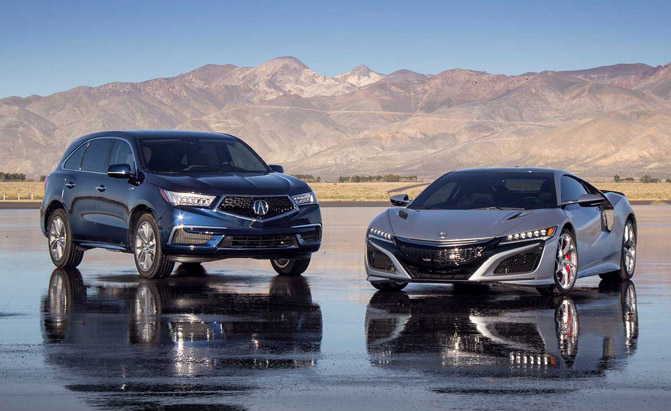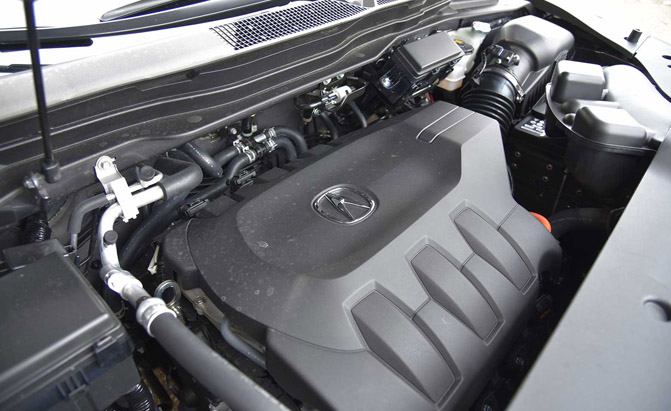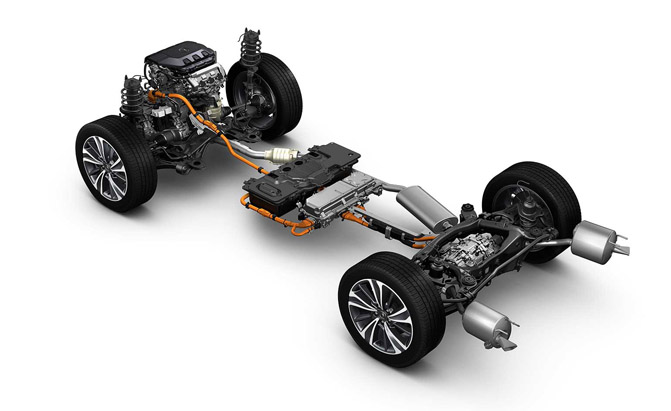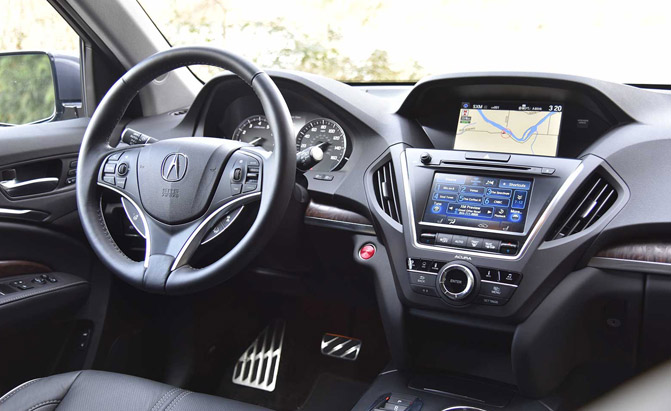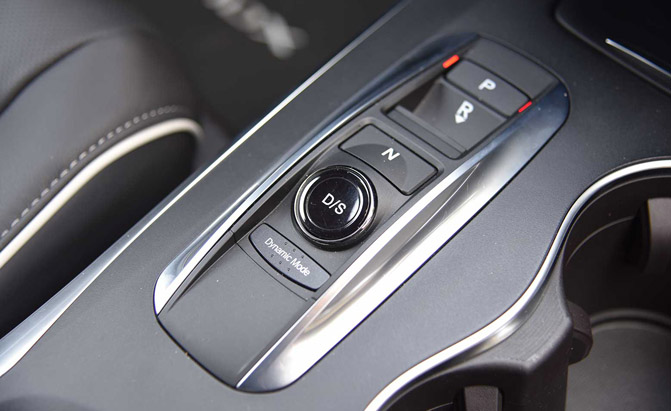According to the fine folks at Acura, its MDX family hauler is the best-selling three-row luxury SUV of all time.
Supporting this claim, drivers have snapped up some 50,000 examples annually for five consecutive years. This is obviously a hugely important product for the Japanese brand.
To keep the MDX fresh, the company’s design and engineering teams refreshed it for 2017, adding more features and technology while increasing luxury. But the biggest change they made is the addition of a gasoline-electric model, which offers greater performance and significantly enhanced efficiency.
Don’t believe me? Well, here’s proof: The new MDX Sport Hybrid variant is rated at 26 miles per gallon in urban driving and 27 on the highway (9.1 L/100 km city, 9.0 highway); that’s practically compact-car efficiency from just a few years ago, all with an engine that whips up 321 horsepower.
Get the Flash Player to see this player.
Three Motors, Two Clutches, One Surprising Parts Car
How did they deliver these impressive figures in an SUV that weighs some two and a quarter tons? Acura engineers drew on their considerable experience building hybrids, borrowing a bunch of components and technology from the NSX.
That’s right, this utility vehicle shares several significant parts with the brand’s revered supercar. For instance, these two models use the exact same motors, battery cells, and power-control unit.
The heart of the MDX’s hybrid drivetrain is a 3.0-liter gasoline V6 that delivers 257 horsepower and 218 lb-ft of torque on its own. Bolstering those figures is a trio of electric motors. One is buried inside the transmission while the other two are found at the rear axle where they provide torque-vectoring all-wheel drive. The rear wheels are only driven by these motors; no mechanical prop-shaft sprouts from the transmission. Storing and releasing electrons as needed is a small 1.3-kWh lithium-ion battery pack.
With six cylinders burning and three motors turning, total system output peaks at 321 horsepower and 289 lb-ft of torque, 31 more horses than in a non-hybrid MDX, with, as mentioned, up to 45 percent better city fuel economy.
Welcome Enhancements
The MDX range has been refreshed for 2017, with the most obvious visual change being the addition of Acura’s “Diamond Pentagon Grille.” Helping integrate this new styling motif is a reworked hood and new front fenders. Rounding things out, the sills have been tweaked, as has the rear fascia, which now gains dual-exhaust outlets.
Sport Hybrids feature standard 20-inch wheels, but other additions for the new model year include things like LED headlamps with automatic high beams, an electronic parking brake, and convenient capless fuel filler. Seven exterior colors are available, while the interior can be had in four different hues.
Pausing for a little inward reflection, the Sport Hybrid’s cabin is appropriately premium with bountiful soft plastics and beautiful open-pore wood trim in models equipped with the top-level Advance Package. It’s just a shame the vehicle’s two-screen infotainment system is so clunky and confusing. This is one aspect that definitely needs work.
Increasing versatility, the MDX’s cushy (and optional) second-row bucket seats fold and slide at the push of a button, making access to the way-back as easy as possible. Unfortunately, its rear-most accommodations are best reserved for small children, though that’s no surprise
.
But what is rather shocking is this vehicle’s versatility. Since all its hybrid bits are basically mounted underneath the floor, there’s no loss in cargo space, which maxes out at more than 68 cubic feet when all the seats are folded flat.
The Drive
Punch it, and the Sport Hybrid is unexpectedly quick for an SUV, with the engine pulling vigorously, especially as it approaches redline. This trait seems especially noticeable in the Sport+ setting, one of four different drive modes provided by the vehicle’s Integrated Dynamics System, which allows you to tailor the suspension, steering, and powertrain-performance feel to your preference.
This electrified MDX features an Acura-designed seven-speed automatic transmission. Surprisingly, it seems to be very well behaved. Initially, I was worried it might shudder or jerk like other dual-clutch models on the market but that was not the case. In fact, my only complaint with this gearbox centers on its odd electronic shifter. I don’t know how many times I put it in reverse when I wanted to go forward.
Aside from this small user-interface complaint, the powertrain is pretty seamless. While driving, the engine will shut off at times, allowing the Sport Hybrid to sail along on battery power for short periods. When internal combustion resumes once more, there’s scarcely any indication that hydrocarbons are being oxidized; the only real tell is that the tachometer needle starts moving.
Enhancing safety and convenience, the AcuraWatch suite of advanced driver-assistance technology is standard in every new MDX. This includes features like adaptive cruise control, road-departure mitigation, and forward collision warning. But perhaps the best thing is lane-keep assist, which is damn good. If there are decent lines on the road, you can take your hands off the steering wheel for an uncomfortably long time, though this is by no means recommended. During testing, I kept my paws hovering just an inch or two away from the wheel’s rim so I could resume control in a split second if necessary, though I never needed to. I eventually got tired of holding my arms out in front of me and resumed steering normally.
The Sport Hybrid’s ride is quiet and composed, even on coarse, rain-battered roads, which can cause quite a commotion in less-insulated vehicles. Curiously, I didn’t notice much of a difference between Comfort, the softest setting offered by the Integrated Dynamics System and Sport+, the most aggressive. The vehicle’s ride seems to be universally smooth, though my opinion might be different had I had tested it on more bomb-cratered surfaces, such as the ones found in my home state of Michigan.
This electrified model is positioned as the most luxurious and performance-oriented offering in the MDX range. Compared to a standard all-wheel-drive version with the uplevel Advance Package, Sport Hybrid models seem to perform comparably despite being some 227 pounds porkier (they tip the scale at a claimed 4,484 pounds). Of course, this is at least partially offset by an additional 31 peak horsepower (combustion-powered variants have 290 ponies on tap). The tit-for-tat continues, as hybridized versions feature a quick-shifting dual-clutch automatic, but the combustion variant has two more gears in its ratio stack. Which one has the edge? Truth be told, their acceleration is probably strikingly similar. With a full battery, the Sport Hybrid ought to hit 60 miles an hour in the neighborhood of six seconds.
When it comes to cornering, the MDX exhibits remarkable body control, staying flat through tight turns at speeds that are enough to make its tires squeal. In theory, the Super-Handling All-Wheel-Dri
ve system should help it change direction with greater enthusiasm; in practice, it seems rather pointless as nobody should be pushing an SUV hard enough on the street to worry about getting the body to rotate.
Complaints about the way this vehicle drives are minor. I find the steering to be a touch too light and I’d like more aggressive regenerative braking from the powertrain. When I take my foot off the accelerator this vehicle keeps on rolling; I would prefer it to start slowing down, putting energy back into the battery pack.
Unlike other hybrids, the brake pedal feels pretty natural underfoot, though, again, more regen would be appreciated. At initial application not much seems to happen, the vehicle doesn’t slow down very much, a heftier stab of the decelerator is required to really slow things down, which is probably dissipating all your forward momentum as heat. I’d rather have it go into the battery, though with a capacity less than 1.5 kWh it’s probably full after just a handful of brake applications so it really doesn’t matter.
The Verdict: 2017 Acura MDX Sport Hybrid Review
Aside from being an all-around solid product – offering a comfortable and luxurious cabin, engaging dynamics and stellar fuel efficiency – competitive pricing won’t hurt the Sport Hybrid’s showroom performance, either. In fact, the addition of this electrified model will probably only increase the MDX’s longstanding sales lead over rival models. It starts at right around $53,000 in the U.S. including delivery fees, just $1,500 more than an all-wheel-drive gasoline-powered model. If you’re interested in driving one of these electrified Acuras home, examples should be arriving at dealerships as you read this.
Discuss this story on our Acura MDX Forum







